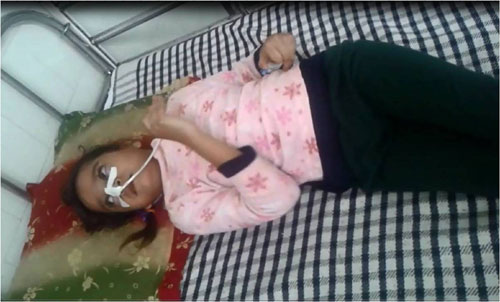|
|
|
Indian Pediatr 2016;53: 81 |
 |
Hyperkinetic Movement Disorder in a Girl with
Anti-NMDA Receptor Encephalitis
|
|
Renu Suthar, Naveen Sankhyan and
*Pratibha Singhi
Department of Pediatrics, Advance Pediatric Center,
PGIMER, Chandigarh, India.
Email:
[email protected]
|
|
An 8-year-old girl previously in good health presented with history of
five days of acute onset confusion, impaired speech, lack of sleep, two
episodes of brief generalized seizures and involuntary movements. On
examination, she was completely unaware, agitated, and mute. She had
peculiar repetitive, rapid, eyelid, ocular and oro-facial dyskinesias,
accompanied with continuous choreo-athetoid movements (Fig.
1 and Web Video 1). Neuroimaging was
normal. Cerebrospinal fluid was acellular with normal proteins and
sugar. A diagnosis of Anti-N-methyl-D-aspartate (anti-NMDA) receptor
encephalitis was confirmed by demonstration of CSF anti-NMDA receptor
antibodies. She was initiated on methylprednisolone (30 mg/kg/day for 5
days) and intravenous immunoglobulins pulse (1g/kg, for 2 days). She
responded remarkably to treatment with cessation of all movement
abnormalities and full recovery of consciousness, speech, cognition and
sleep pattern. She started attending regular school after a month of
treatment.
 |
|
Fig. 1 Movement disorder in anti-NMDA receptor
encephalitis. (See video at website).
|
In anti-NMDA receptor encephalitis, oro-lingual-facial
dyskinesias are the most characteristic movement abnormality. This
movement disorder frequently occurs along with limb and trunk
choreoathetosis, oculogyric crisis, dystonia, rigidity, and opisthotonic
postures. This pattern of movement disorder is important to recognize
because this disorder is a treatable cause of severe neuro-morbidity.
Resembling movements disorders can occur in children due to drugs or
toxins, basal ganglia involvement in viral encephalitis, Syndenham
chorea, neurometabolic disorders, or hypoxic/ischemic insult to the
basal ganglia. Symptomatic treatment of the hyperkinetic movement
disorder may be difficult but drugs like valproate, haloperidol,
benzodiazepines, and tetrabenazine have been tried.
Acknowledgement: Dr Josep Dalmau (Research
Professor ICREA-IDIBAPS, Service of Neurology, Hospital Clínic,
University of Barcelona) for his help in diagnosis of this child.
|
|
|
 |
|

